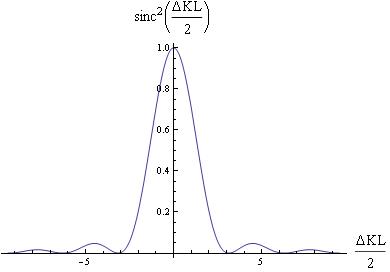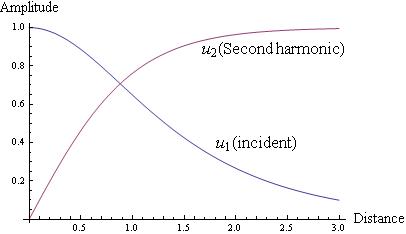I modeled the effect of $\bigtriangleup k$ using the equation:
(1) 
2.2.20 Nonlinear optics Robert W.Boyd
This can be simplified to $I_{3} = I_{3}(max)\frac{\sin^{2}(\frac{\bigtriangleup kL}{2})}{(\frac{\bigtriangleup kL}{2})^{2}}$
Fig 2.2.2 Nonlinear optics Robert W.Boyd
Link to mathematica code https://vspace.vassar.edu/tasanda/sinc.nb
It shows the harmonic generation output as a function of the phase match $\bigtriangleup k$ when $\bigtriangleup k \sim 0$
Link to mathematica code https://vspace.vassar.edu/tasanda/Manipulation.nb
This model shows the effect of superposition of waves and explains why intensity is largest when $\bigtriangleup k=0$
Deriving Efficiency
Solving the general wave equations for the two frequencies $\omega_{1}$(incident) and $\omega_{2}$(Second harmonic) we obtain coupled-amplitude equations.
(2) ![]()
(3) ![]()
2.6.10, 2.6.11 Nonlinear optics Robert W.Boyd
Where $\bigtriangleup k = 2K_{1}-k_{2}$ is the wave vector mismatch. Integrating these equations gives us
$A_{1}=(\frac{2\pi I}{n_{1}c}) u_{1}e^{i\phi_{1}}, A_{2}=(\frac{2\pi I}{n_{2}c})u_{2}e^{i\phi_{2}$
2.6.13, 2.6.14 Nonlinear optics Robert W.Boyd
The new field amplitudes $u_{1}$ and $u_{2}$ are defined such that $u_{1}(z)^{2} + u_{2}(z)^{2} = 1$(conserved normalized quantity). Next we introduce a normalized distance parameter
$\zeta=\frac{z}{l}$ where $l=(\frac{n^{2}_{1}n_{2}c^{3}}{2\pi I})^{\frac{1}{2}}\frac{1}{8\pi \omega_{1} d}$
2.6.18, 2.6.19 Nonlinear optics Robert W.Boyd
$l$ is the distance over which the fields exchange energy.
$\frac{du_{1}}{d\zeta}=u_{1}u_{2}sin\theta$ and $\frac{du_{2}}{d\zeta}=-u^{2}_{1}sin\theta$.
2.6.22, 2.6.23 Nonlinear optics Robert W.Boyd
If we assume $cos\theta=0$ and $sin\theta=-1$ the equations simplify to $\frac{du_{1}}{d\zeta}=-u_{1}u_{2}$ and $\frac{du_{2}}{d\zeta}=u^{2}_{1}$
2.6.31, 2.6.32 Nonlinear optics Robert W.Boyd
The second equation can be written as $\frac{du_{2}}{d\zeta}=1-u^{2}_{2}$(from conservation).
Hence $u_{2}=tanh(\zeta+ \zeta_{0})$. Initially we assume there is only the incident beam and no harmonic generation hence $u_{1}(0)=1, u_{2}(0)=0$. Therefore $u_{2}= tanh\zeta$ and $u_{1}=sech\zeta$. Plotting these two equations below shows that incident waves are converted into the second harmonic.
Fig 2.6.3 Nonlinear optics Robert W.Boyd
Link to mathematica code https://vspace.vassar.edu/tasanda/u1u2.nb
The efficeincy $\eta$ for the conversion of power from incident wave $\omega_1$ to $\omega_{2}$ is
(4) ![]()
2.6.43 Nonlinear optics Robert W.Boyd
From the diagram it seems like increasing the medium length will increase the amplitude but doing so is not practical. Generally a higher pump intensity leads to a larger $\eta$ except to the limit of very high conversion efficiency.
Taking an example of a medium of 1cm length, the efficiency equals $tanh^{2}(1)$ which is $58\%$





Your graph showing the relationship between and
and  is quite clear! It’s good that the graph is simple enough for anyone to read, and that the expected outcome (that
is quite clear! It’s good that the graph is simple enough for anyone to read, and that the expected outcome (that  peaks when
peaks when  ) is what we’d expect, just from knowing about perfect constructive interference from introductory physics! When you inserted your equation for intensity into Mathematica, I noticed that the
) is what we’d expect, just from knowing about perfect constructive interference from introductory physics! When you inserted your equation for intensity into Mathematica, I noticed that the  term was replaced with
term was replaced with  ; is this a typographical error, or is it actually a function different from a normal sine function (like hyperbolic sine, for example)? Although your graph of intensity shows a clear trend on its own, you could comment on why the intensity periodically increases and decreases as the difference in wave vector
; is this a typographical error, or is it actually a function different from a normal sine function (like hyperbolic sine, for example)? Although your graph of intensity shows a clear trend on its own, you could comment on why the intensity periodically increases and decreases as the difference in wave vector  deviates from zero. Additionally, in the graph of the conversion of incident waves to the second harmonic waves, is there a reason why the rate of increase of the second harmonic is greater than the rate of decrease of the incident? Why doesn’t total amplitude have to be conserved; or even, is it not supposed to be conserved?
deviates from zero. Additionally, in the graph of the conversion of incident waves to the second harmonic waves, is there a reason why the rate of increase of the second harmonic is greater than the rate of decrease of the incident? Why doesn’t total amplitude have to be conserved; or even, is it not supposed to be conserved?